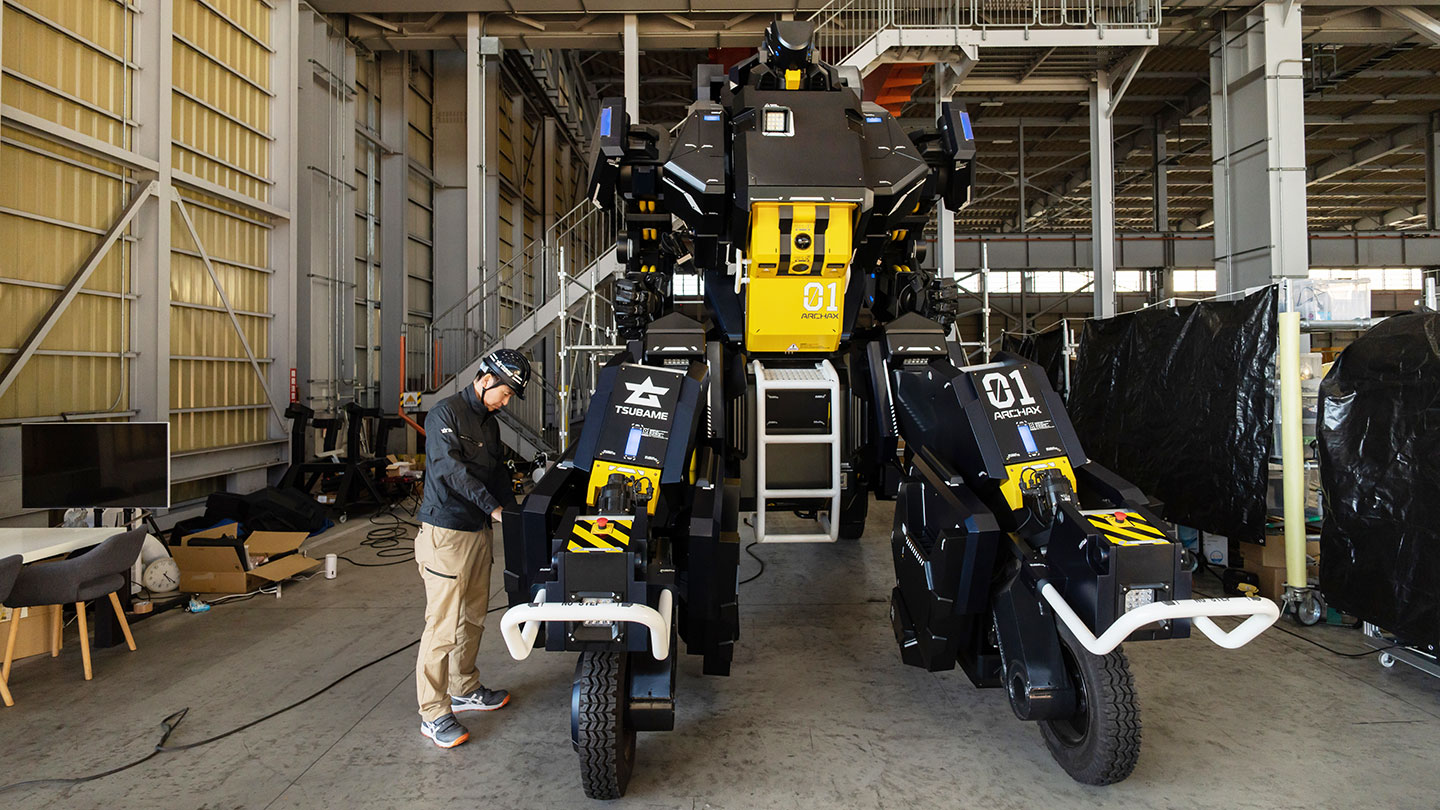Could we build a mecha?
These giant robots might be better suited for construction work than fighting crime

The piloted robot Archax, in Japan, is one of several real-life mechas. This 4.5-meter (14.8-foot) tall machine weighs a whopping 3.5 tons.
Tomohiro Ohsumi/Stringer/Getty Images
Optimus Prime from The Transformers rearranges his body parts to become a semitrailer truck. In the Gundam series, pilots battle in space using massive mobile suits. Power Rangers fuse smaller machines together to fight crime as a humanoid robot, Megazord.
Called mechas, these larger-than-life robots have what it takes to save the day. But would these giants hold up in real life?
If you travel to Yokohama, Japan, you can find a real-life Gundam. Sort of. Standing at 18 meters (59 feet) tall, this huge robot can’t fly in space or wield laser beam sabers. But it can bend down on one knee and move its fingers. It currently holds the Guinness World Record for the largest mobile humanoid robot. (Editor’s note: The Yokohama Gundam was removed from display in April 2024.)
Certain giant robots are more realistic than others, says Sangbae Kim. He’s the director of the Biomimetics Robotics Laboratory at the Massachusetts Institute of Technology in Cambridge. Engineering a Transformer that morphs in mere seconds would be trickier than crafting a Gundam mobile suit that keeps its shape, he says.
There aren’t too many technological barriers to making a rearranging robot, says Robert Siddall. At the University of Surrey in England, this engineer studies how animal movements can help people build better robots. Matching the speed of a Transformer rearranging itself mid-jump, though, would require extreme accelerators on all of its interchanging parts.
Some Transformers also shapeshift into vehicles that would need to use physics in opposing ways. Take Seaspray. This mecha can fly above the water as a hovercraft and swim in the ocean. “Flying submarines are tricky because you’ve got quite a big change,” says Siddall. Flight requires “really big, lightweight structures.” But a robot swimming underwater would need to be as dense and hydrodynamic as possible.
Mecha made
Roboticists have already built simple mechas. The Japanese company Suidobashi Heavy Industry unveiled its rideable mecha, Kuratas, in 2012. This 4-meter (13-foot) tall robot sports four wheels and a pair of massive arms. And in 2017, Amazon founder Jeff Bezos rode in the Method-2, a 4.1-meter (13.5-foot) tall walking mecha built by South Korean roboticists from Hankook Mirae Technology.
But unlike their film counterparts, these smaller mechas move very slowly, says Siddall. “They don’t move in that dynamic way that you sort of hope to see in the movies.”
Part of this has to do with the square-cube law. As an object gets taller, its surface area increases by the square of its height. Its volume, in turn, increases by the cube of its height. By doubling the height of an object, its strength quadruples while its weight increases eightfold.
This law applies to animals as well, says Siddall. Large animals, though, evolved ways to help carry their weight. Sauropod dinosaurs such as Brachiosaurus and Diplodocus had hardened tendons in their long necks to help hold up their heads, studies suggest. Elephants have foot pads to help distribute their weight and allow them to run.
Adding squishy and pliable footpads might help divert energy, says Siddall. Reinforcing the robot’s body with rubber could also add extra shock absorption. This rubber would serve a similar purpose as bone does in our bodies. Though only as strong as fiberglass, human bone is more flexible than steel. This springiness helps diffuse the force of high-impact movements, like sprinting and jumping.
Running might still be too much for a mecha, though. When a person runs, each heel produces a force three to four times their body weight. For a 77-kilogram (170-pound) person, that’s nearly 318 kilograms (700 pounds) of pressure traveling up from the foot. The Yokohama Gundam weighs 25 tons, or roughly the same as five male African elephants. “A walking robot as big as a Gundam is doable,” says Kim. But a real-life mecha could easily break from the impact of a quick run or accidental fall.
Swapping steel for titanium could lighten a mecha’s frame. Titanium weighs about half as much as steel but is just as strong. It’s often combined with other metals when building high-speed aircraft and spacecraft. Titanium could also be reinforced with carbon fiber, says Kim. Made of tiny carbon filaments, this material is also lightweight and strong.
In the movies, mechas are the perfect fighting machines. These robots rely on their bulk to squash crime and muscle through dangerous situations. A real mecha would probably be more sluggish and uncoordinated than its brawny counterparts. What job would a real-life robot have?
“The closest thing I can think of is a glorified excavator,” says Kim. Excavators clear heavy debris and dig trenches using a mechanical arm. These heavy construction vehicles often rely on other specialized machines, such as dump trucks and bulldozers, to finish a job. A single mecha could do the work of several machines while also being easier to control.
Such giant workers could help with mining or offshore construction. They might even assemble structures in near-Earth orbit, says Siddall. Future humans might rely on mechas for building space stations or space habitats. These large-scale settlements would need to be kilometers (miles) wide to sustain artificial gravity. Siddall says, “At that point, you’d probably start to want to use bigger and bigger robots.”
Do you have a science question? We can help!
Submit your question here, and we might answer it an upcoming issue of Science News Explores







